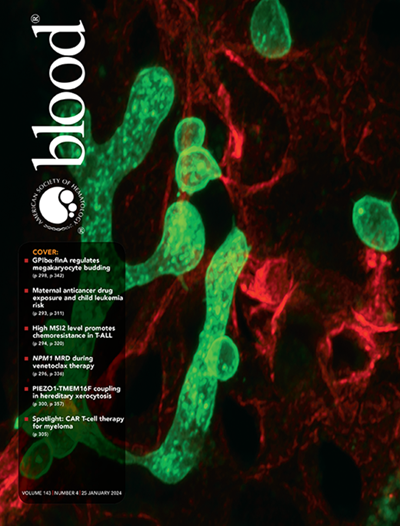MZL亚型生物学:分类的挑战和相关性。
IF 23.1
1区 医学
Q1 HEMATOLOGY
引用次数: 0
摘要
边缘区淋巴瘤(MZLs)是一种异质性的低级别b细胞肿瘤,根据目前的淋巴瘤分类分为不同的实体。它们有一些共同的特征,但在临床表现、相关炎症条件、受累解剖部位和分子改变方面存在显著差异。发病机制与慢性抗原刺激和特异性感染或结外疾病的自身免疫性疾病密切相关。遗传标志包括组成性NF-κB激活,常见的3和18三体,以及亚型特异性病变,如结外MZL易位,淋巴结和脾MZL复发性KLF2/NOTCH2突变,以及主要在脾MZL中观察到的涉及染色体7q的缺失。由于与滤泡性淋巴瘤和淋巴浆细胞性淋巴瘤等其他淋巴瘤的重叠特征,诊断可能具有挑战性;整合形态学、免疫表型和分子数据是必不可少的。向侵袭性DLBCL的转化发生在3-15%的病例中,并且与遗传病变的积累有关,特别是在细胞周期、NF-κB和表观遗传调节因子中,具有亚型特异性驱动因素,如TNFAIP3、TP53和CDKN2A/B改变。肿瘤微环境发挥着至关重要但尚未得到充分研究的作用,受慢性抗原刺激的影响,涉及与免疫细胞的复杂相互作用,可以促进免疫抑制并影响治疗反应。了解MZLs在其分类、遗传景观和与微环境相互作用方面的异质性对于准确诊断、预后和开发有效的靶向治疗至关重要。本文章由计算机程序翻译,如有差异,请以英文原文为准。
The Biology of MZL subtypes: Challenge and Relevance of Classification.
Marginal zone lymphomas (MZLs) are a heterogeneous group of low-grade B-cell neoplasms classified into different entities by the current lymphoma classifications. They share some features, but differ significantly in clinical presentation, associated inflammatory conditions, anatomical sites of involvement, and molecular alterations. Etiopathogenesis is strongly linked to chronic antigenic stimulation and specific infections or autoimmune disorders for extranodal disease. Genetic hallmarks include constitutive NF-κB activation, and common trisomies 3 and 18, alongside subtype-specific lesions such as translocations in extranodal MZL and recurrent KLF2/NOTCH2 mutations in both nodal and splenic MZL, and deletions involving chromosome 7q, predominantly observed in splenic MZL. Diagnosis can be challenging due to overlapping features with other lymphomas like follicular lymphoma and lymphoplasmacytic lymphoma; integrating morphology, immunophenotype, and molecular data is essential. Transformation to aggressive DLBCL occurs in 3-15% of cases and is associated with the accumulation of genetic lesions, particularly in cell cycle, NF-κB, and epigenetic regulators, with subtype-specific drivers like TNFAIP3, TP53, and CDKN2A/B alterations. The tumor microenvironment plays a critical but understudied role, influenced by chronic antigen stimulation and involving complex interactions with immune cells that can promote immune suppression and influence therapeutic response. Understanding the heterogeneity of MZLs across their classification, genetic landscapes, and interaction with the microenvironment is crucial for accurate diagnosis, prognosis, and the development of effective targeted therapies.
求助全文
通过发布文献求助,成功后即可免费获取论文全文。
去求助
来源期刊

Blood
医学-血液学
CiteScore
23.60
自引率
3.90%
发文量
955
审稿时长
1 months
期刊介绍:
Blood, the official journal of the American Society of Hematology, published online and in print, provides an international forum for the publication of original articles describing basic laboratory, translational, and clinical investigations in hematology. Primary research articles will be published under the following scientific categories: Clinical Trials and Observations; Gene Therapy; Hematopoiesis and Stem Cells; Immunobiology and Immunotherapy scope; Myeloid Neoplasia; Lymphoid Neoplasia; Phagocytes, Granulocytes and Myelopoiesis; Platelets and Thrombopoiesis; Red Cells, Iron and Erythropoiesis; Thrombosis and Hemostasis; Transfusion Medicine; Transplantation; and Vascular Biology. Papers can be listed under more than one category as appropriate.
 求助内容:
求助内容: 应助结果提醒方式:
应助结果提醒方式:


